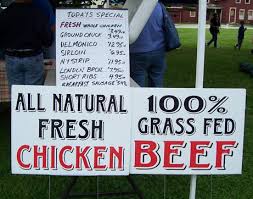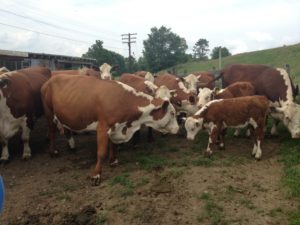A Quick Primer on Marketing Your Livestock for Meat
“I believe in leadership from ourselves and respect from others. I believe in my own ability to work efficiently and think clearly, with such knowledge and skill as I can secure, and in the ability of progressive agriculturists to serve our own and the public interest in producing and marketing the product of our toil”.
This quote is from the FFA Creed, an inspirational document that has been guiding FFA members and high school Agriculture teachers for decades. I refer to it as it has been around for many years, and has served as a guiding philosophy that can apply to agricultural producers everywhere. Growing animals is what many farmers and producers love to do, and do so well; we raise them, nurture them, feed them, and care for them in blistering hot weather and during the frigid days of our northeastern winters. Many of us are good at this, but sometimes fall short in selling these animals for a profit. Sooner or later we have to sell, or market these animals to keep cash flow going, to pay our bills, and to finance our lives and our businesses’ next trip around the sun.
Frequently I get phone calls from people who desire to grow any number of animal or poultry oriented enterprises, and the majority of questions are production oriented, with little or no thought given to marketing. There seems to be this “mythical they” such as some government agency which will swoop in and assist in helping producers make huge profits when the time comes to sell their products. Sadly, no such “they “ exists; we need to start small and develop our own markets as we gain skills and then increase our animal and bird populations to fit those markets.

Livestock products can be marketed at Farmers Markets but take large amounts of work and attention needs to be paid to keeping products at the correct temperatures.
There are several different ways to sell your meat products, and all require a good bit of effort, time, expense, and sometimes, aggravation, to succeed.
My first piece of advice to aspiring producers is to start small, and to make your mistakes while you have fewer animals to contend with. Nothing can be more costly and demoralizing than to have a whole bunch of animals ready to be sold, and you have no viable market, and you end of having to sell them for low and unprofitable prices. As you build your marketing skills and client base, you can grow your animal populations to fit those markets.
I will also mention at the outset, that if you wish to sell meat products (lamb, pork, beef, veal, goat) to consumers in New York State, then the animals have to be slaughtered at USDA inspected meat processing facilities. This is non-negotiable. If you wish to have animals processed only for your own consumption, they can be processed at non-USDA facilities, but they will be stamped “not for resale”. Hefty fines can occur if you violate this law.
Poultry, on the other hand, in New York State can be processed at home for resale to consumers. For more information on processing meats and poultry, go to the Cornell Small Farms website, and go to the “Resources” section. There is an excellent publication that can be downloaded, and which explain all of the rules and regulations applicable to these topics, and is titled “A Resource Guide to Direct Marketing Livestock and Poultry”. Different states have completely different rules and regulations and so for those readers from states other than New York you will need to contact your respective state agencies for applicable rules.
So then what are some of our existing and viable channels by which we can market our products?
Before mentioning any specific methods of marketing, we need to keep one paramount thought in mind, and that is that animal products are perishable products, and must be strictly held to certain temperatures, anywhere from zero degrees for frozen products, to forty degrees for products that will be readily consumed. This can be a daunting task at times.

There are a lot of steps, effort, rules, and regulations between these farm-raised animals and a marketable product. Farmers markets, CSAs, wholesale markets, and direct farm sales are all viable methods of getting products to the consumer.
Direct Marketing is a very popular way of selling to the public, and can be manifested in several different ways. The first is the ever-popular Farmers Market. This is an excellent way to meet with your customers and to build a client base. However, farmers markets can take an inordinate amount of time to prepare for, work at, and then pack up and return home. Many small-scale farmers have outside employment, and can find it burdensome to work, raise animals, and then be involved in a farmers market, which can be grueling in time commitments.
A producer can develop an online presence, and have customers come to your location to pick up products. However, you have to have a strict protocol as to when they can come to your farm to pick up things. You may be wanting to only sell a few products to any given customer; they may be looking for “the whole farm experience” and expect you to drop whatever it is you are doing and give them a grand tour of your farm.
Selling for wholesale markets is a developing and emerging way to market your products. As we speak, the Cornell Small Farms Program has assembled a team of Extension Educators who are developing a curriculum to teach producers how to wholesale market their commodities. Wholesale marketing will allow for those who have neither the desire nor the wherewithal for farmers markets to expeditiously sell their products. One example that is occurring right now is the Cornell Beef Calf Pooling Program, led by Beef Specialist Mike Baker. Uniform groups of beef calves will be assembled around the state and then marketed to buyers online, ensuring producers a better price and a ready market.
Community Supported Agriculture (CSAs) are another method to market products, and which seems to be more popular with vegetable growers but several successful livestock CSAs have occurred. People in the community pay fees upfront, such as in the beginning of the season, and at specified times throughout the year receive a designated amount of products.
Restaurants and institutions offer another way to market animal products, but take a good amount of effort to develop these contacts. Supplying a specified amount of products to those outlets can be a formidable task for small-scale producers.
Another outlet that can be productive is the auction barn, where meat buyers congregate. In recent years beef prices have been fairly high, and animals have brought a good price at these outlets. Over the years, though, when prices are depressed, you can receive very disappointing prices at the auction barn.
These are just a few of the methods available that can be used to market your birds and animals. Again, start small, go slowly, and develop your markets as your skills develop. Don’t wait until its time to sell your products without a marketing plan in place; by then it may well be too late.


I like how you mentioned that you can sell your livestock at the farmer’s market. My wife and I are wanting to start selling our livestock and we were wondering where we could market our cattle at. I’ll be sure to find a local farmers market and try to sell our livestock there.